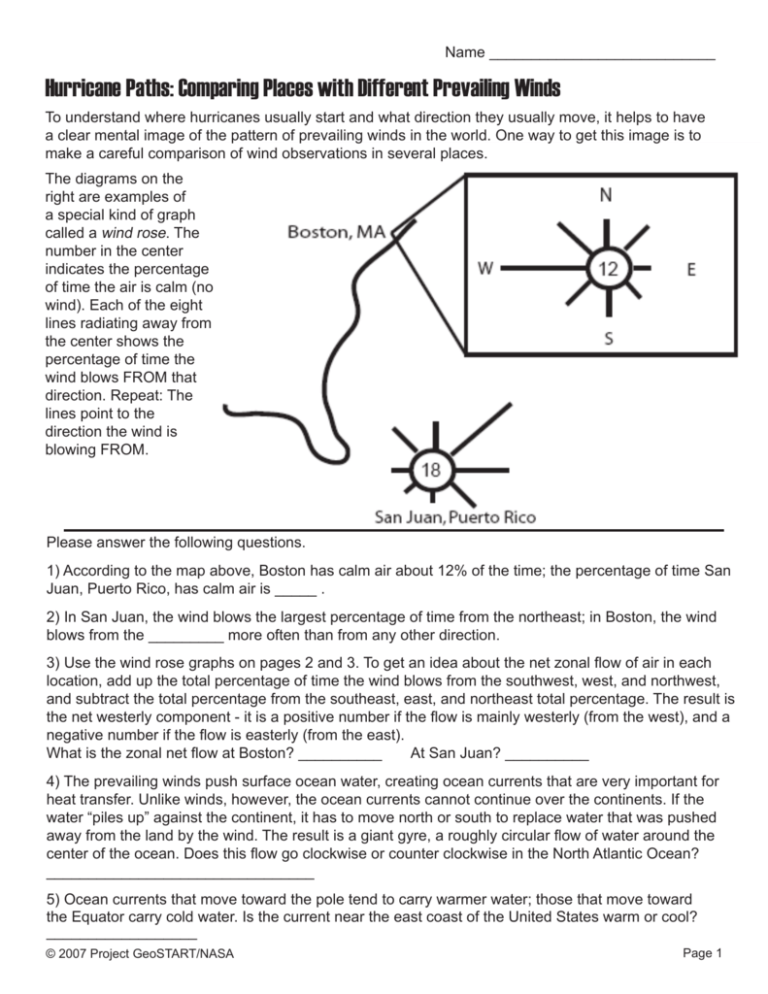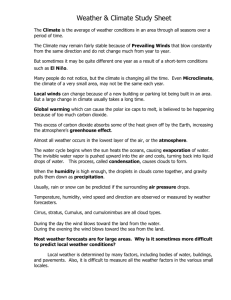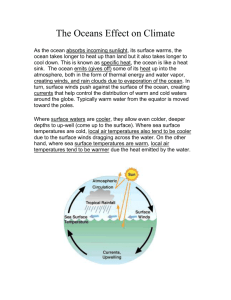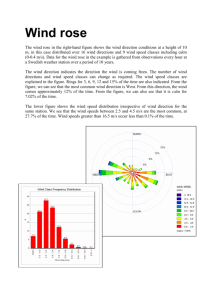Hurricane Paths: Comparing Places with Different Prevailing Winds
advertisement

Name ___________________________ Hurricane Paths: Comparing Places with Different Prevailing Winds To understand where hurricanes usually start and what direction they usually move, it helps to have a clear mental image of the pattern of prevailing winds in the world. One way to get this image is to make a careful comparison of wind observations in several places. The diagrams on the right are examples of a special kind of graph called a wind rose. The number in the center indicates the percentage of time the air is calm (no wind). Each of the eight lines radiating away from the center shows the percentage of time the wind blows FROM that direction. Repeat: The lines point to the direction the wind is blowing FROM. Please answer the following questions. 1) According to the map above, Boston has calm air about 12% of the time; the percentage of time San Juan, Puerto Rico, has calm air is _____ . 2) In San Juan, the wind blows the largest percentage of time from the northeast; in Boston, the wind blows from the _________ more often than from any other direction. 3) Use the wind rose graphs on pages 2 and 3. To get an idea about the net zonal flow of air in each location, add up the total percentage of time the wind blows from the southwest, west, and northwest, and subtract the total percentage from the southeast, east, and northeast total percentage. The result is the net westerly component - it is a positive number if the flow is mainly westerly (from the west), and a negative number if the flow is easterly (from the east). What is the zonal net flow at Boston? __________ At San Juan? __________ 4) The prevailing winds push surface ocean water, creating ocean currents that are very important for heat transfer. Unlike winds, however, the ocean currents cannot continue over the continents. If the water “piles up” against the continent, it has to move north or south to replace water that was pushed away from the land by the wind. The result is a giant gyre, a roughly circular flow of water around the center of the ocean. Does this flow go clockwise or counter clockwise in the North Atlantic Ocean? ________________________________ 5) Ocean currents that move toward the pole tend to carry warmer water; those that move toward the Equator carry cold water. Is the current near the east coast of the United States warm or cool? __________________ © 2007 Project GeoSTART/NASA Page 1 Wind Rose for Boston Page 2 Wind Rose for San Juan Page 3 Wind Speed and Directions for Puerto Rico (locate the island of Puerto Rico to interpret the graph data) The arrows in the graphic above indicate wind flow direction (vectors). The numbered, dashed contour lines indicate wind speed measured in knots. Blue lines show strong winds. Red lines are weaker winds. Page 4 Wind Speed and Directions for the East Coast (locate Boston to interpret the graph data) The arrows in the graphic above indicate wind flow direction (vectors). The numbered, dashed contour lines indicate wind speed measured in knots. Blue lines show strong winds. Red lines are weaker winds. Page 5








